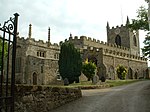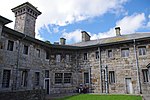Victoria Terrace, Beaumaris

Victoria Terrace, on the seafront in Beaumaris, Anglesey, Wales is a range of early 19th century townhouses. The terrace was designed by the architectural partnership of Joseph Hansom and Edward Welch for the Beaumaris Corporation. The development was a central part of the corporation's plans to reposition Beaumaris as a fashionable seaside resort in response to its declining maritime trade. The terrace was sold off in the early 20th century and is now divided into nineteen apartments. No. 1 remaining as a single house. This, and each apartment, No.s 2-20 inclusive, is designated a Grade I listed building, the Cadw listing record describing the whole block as "an outstanding and well-preserved late-Georgian terrace of national importance".
Excerpt from the Wikipedia article Victoria Terrace, Beaumaris (License: CC BY-SA 3.0, Authors, Images).Victoria Terrace, Beaumaris
Victoria Street,
Geographical coordinates (GPS) Address Nearby Places Show on map
Geographical coordinates (GPS)
| Latitude | Longitude |
|---|---|
| N 53.2632 ° | E -4.0906 ° |
Address
Heol Victoria Street
Victoria Street
LL58 8BU , Beaumaris
Wales, United Kingdom
Open on Google Maps









